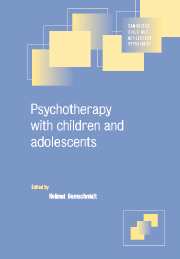Book contents
- Frontmatter
- Contents
- List of contributors
- Preface
- Part I Principles of psychotherapy with children, adolescents and families
- Part II Psychotherapeutic methods and settings
- Part III The practice of psychotherapy for specific disorders in childhood and adolescence
- 15 Anxiety disorders
- 16 Obsessive-compulsive disorder
- 17 Depressive syndromes and suicide
- 18 Dissociative [conversion] disorders
- 19 Disorders of sexual development and sexual behaviour
- 20 Substance abuse and addiction
- 21 Eating disorders
- 22 Psychotherapy in chronic physical disorders
- 23 Enuresis and faecal soiling
- 24 Dyslexia and dyscalculia
- 25 Stuttering
- 26 Hyperkinetic disorders
- 27 Autism
- 28 Schizophrenia
- 29 Conduct disorders, antisocial behaviour, delinquency
- 30 Physical abuse and neglect
- 31 Sexual abuse and sexual maltreatment
- Part IV The practice of psychotherapy in various settings
- Index
18 - Dissociative [conversion] disorders
- Frontmatter
- Contents
- List of contributors
- Preface
- Part I Principles of psychotherapy with children, adolescents and families
- Part II Psychotherapeutic methods and settings
- Part III The practice of psychotherapy for specific disorders in childhood and adolescence
- 15 Anxiety disorders
- 16 Obsessive-compulsive disorder
- 17 Depressive syndromes and suicide
- 18 Dissociative [conversion] disorders
- 19 Disorders of sexual development and sexual behaviour
- 20 Substance abuse and addiction
- 21 Eating disorders
- 22 Psychotherapy in chronic physical disorders
- 23 Enuresis and faecal soiling
- 24 Dyslexia and dyscalculia
- 25 Stuttering
- 26 Hyperkinetic disorders
- 27 Autism
- 28 Schizophrenia
- 29 Conduct disorders, antisocial behaviour, delinquency
- 30 Physical abuse and neglect
- 31 Sexual abuse and sexual maltreatment
- Part IV The practice of psychotherapy in various settings
- Index
Summary
General considerations, definition and classification
The term ‘conversion’ (Freud, 1894) was originally used to describe the process whereby psychic energy contained in an instinctual wish is transformed – or ‘converted’ – into physical symptoms. Conversion symptoms are thus a symbolic representation of repressed instinctual wishes. Psychic equilibrium is restored at the price of a mismatch between the severity of symptoms and the indifferent attitude of the affected individual towards the symptoms (‘belle indifference’). Conversion symptoms are closely related to hysteria. However, in recent years the term hysteria has not only been used in the psychoanalytic sense, but increasingly in a phenomenological and descriptive sense. In the 1920s, hysterical symptom neurosis (conversion) was distinguished from hysterical character (hysterical character neurosis). However, this classification is not precise and allows only a rough distiction, because conversion symptoms also occur frequently in hysterical personalities.
Classification
In the last few years, attempts have been made to distinguish between the disparate symptoms associated with the term hysteria. In ICD-10 the term ‘hysteria’ is avoided ‘in view of its many and varied meanings’ (WHO, 1992). Instead, three different categories associated with the concept are described:
(i) dissociative [conversion] disorders (F44), e.g. dissociative amnesia, dissociative stupor, dissociative convulsions;
(ii) somatoform disorders (F45), e.g. somatization disorder, hypochondriacal disorder, somatoform autonomic dysfunction, persistent somatoform pain disorder;
(iii) histrionic personality disorder (F60.4), which is simalar to the classic ‘hysterical personality’.
In the following section only those conversion symptoms or hysterical disorders relevant to childhood and adolescence are discussed.
- Type
- Chapter
- Information
- Psychotherapy with Children and Adolescents , pp. 306 - 314Publisher: Cambridge University PressPrint publication year: 2001



